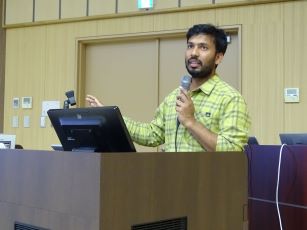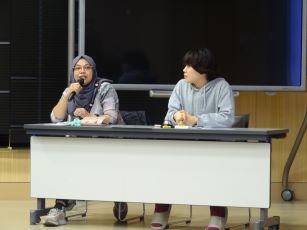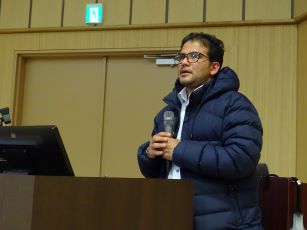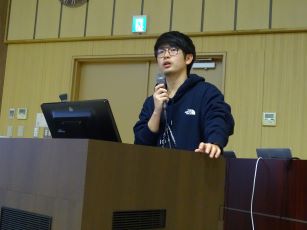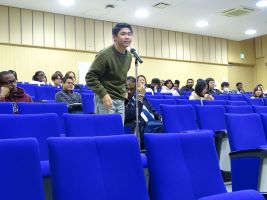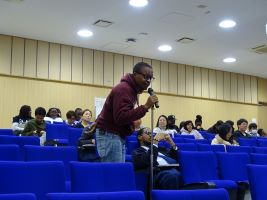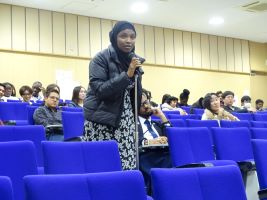- Home
- Student Activity
- Student Monthly Progress #7
The 7th Student Monthly Progress presentation was held on October 27th, 2023.
【Presenters】
1. THAMMAHAKIN Passawat:Laboratory of Public Health
<Detection of disease-associated-microglia among various microglia phenotypes induced by West Nile virus infection in mice>
2. RUBEL Md Zahir Uddin:Laboratory of Anatomy
<Lymphoid tissues in chicken rectal mucosa and factors affecting its morphology>
3. PANDIT Arjun:Laboratory of Wildlife Biology and Medicine
<Elephant Health Crisis: Tuberculosis related mortality in Nepal, 2019-2022>
4. SATO Jumpei:Laboratory of Infectious Diseases
<Insertion in the Meq protein of the avian oncogenic herpesvirus, Marek’s disease virus, accelerates the process of tumorigenesis.>
【Chairpersons】
NESTI Dela Ria:Division of Collaboration and Education
WATANABE Kanami:Laboratory of Toxicology
❖ Chairpersons’ Report ❖
THAMMAHAKIN Passawat’s research is focused on identifying a range of microglia phenotypes in West Nile virus (WNV)-infected mice and disease-associated microglia that may influence WNE pathogenicity. He inoculated mouse WNV (NY-99 strain) and collected the brain to investigate the variety of microglia phenotypes by using marker molecules with immunohistology analysis. He also used immunofluorescent and flow cytometry to determine the phenotype interacting with WNV-infected neurons. As a result, He detected the positive cells of the general microglia marker in both the control and WNV-infected brains, but the morphology was different. He concluded that WNV infection can induce activation of diverse microglia phenotypes and the disease-associated microglia may be associated with the pathogenicity of WNV infection in the mouse brain.
In his research, RUBEL Md Zahir Uddin’s explored rectal mucosa-associated lymphoid tissue (RMALT) morphology and related variables in various ages and sexes of chickens. He used histological observation and ultrastructure scanning to analyze the rectums of Rhode Island Red (RIR) chickens of different ages. As an outcome, he discovered that the total lymphoid tissue count in adults was substantially larger than in chicks. Adult chickens have much bigger RMALT sizes in the rectum than 1-day and 1-month chicks. Furthermore, the mean size of total lymphoid tissues was considerably greater in adult females than in men for sex-related differences. He summarized that age and sex both influenced the placement of lymphoid tissues and immune cell composition in the rectum.
PANDIT Arjun’s research focuses on Tuberculosis-related mortality in Nepal from 2019 to 2022. Tuberculosis poses a significant threat to elephants in Nepal, primarily caused by Mycobacterium tuberculosis. This study aimed to investigate the genetic characteristics of the pathogen responsible for elephant deaths. Testing confirmed the presence of tuberculosis in some elephants, and the analysis indicated possible disease transmission between elephants and humans. The rising prevalence of a specific strain raised concerns regarding drug resistance.
SATO Jumpei’s presentation explores the impact of an insertion in the Meq oncoprotein of Marek's disease virus (MDV) in chickens. Despite vaccination, MDV strains have become more virulent. The insertion (L-Meq) was found to enhance Meq's activity in transactivation assays. Recombinant MDVs with L-Meq had higher mortality and tumor incidence, as well as increased CD4+ T cells after infection. However, there were no significant differences in gene expression in tumor lesions. In summary, the Meq insertion accelerates tumorigenesis and increases virulence by enhancing transactivation activity without affecting target gene regulation.
This event provided a glimpse into the diverse research pursuits of fellow PhD students across various fields. The students actively engaged by asking thought-provoking questions, sparking dynamic discussions with the presenters. Involvement in such activities allows students to expand their research horizons beyond their respective domains and cultivates a collaborative research mindset.

